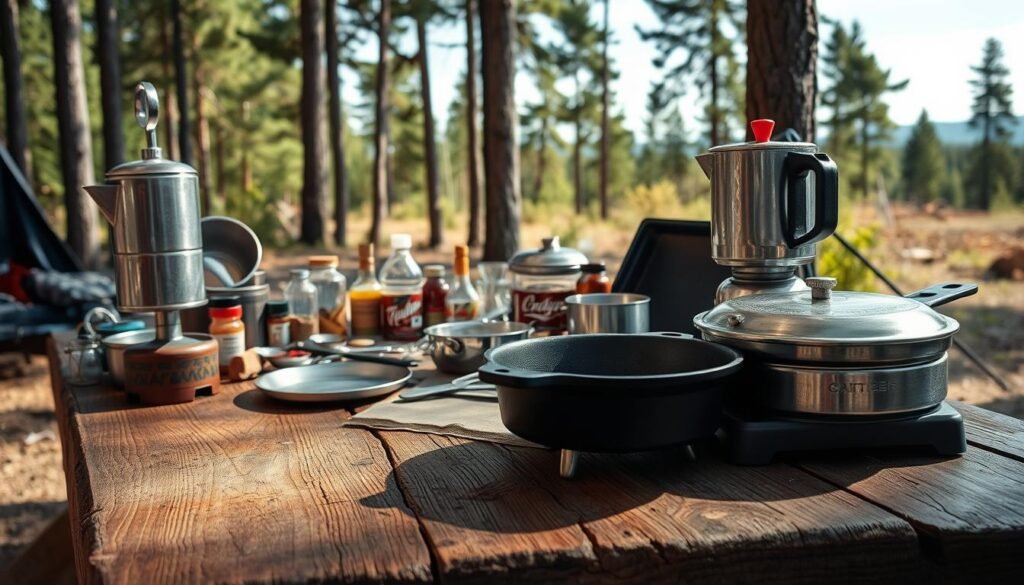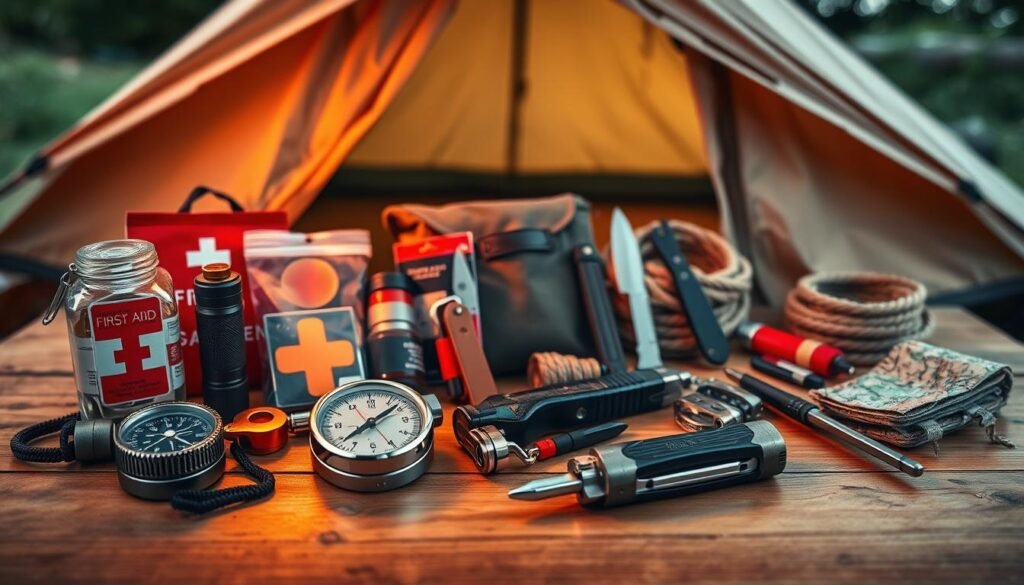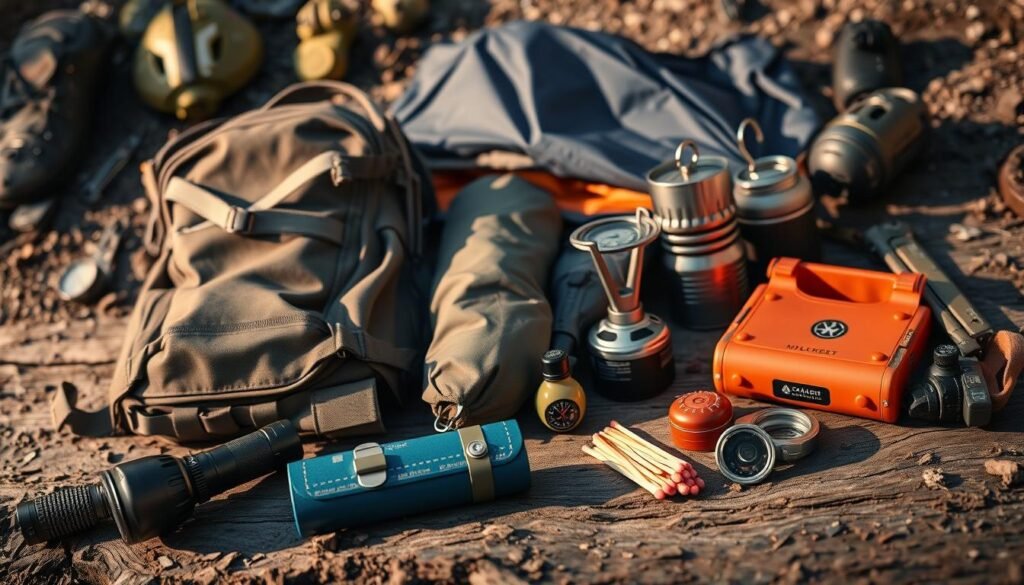Going on a camping trip is exciting. It lets you step away from daily stress and enjoy nature. But, you need to prepare well to have a good time.
Having the right must-have camping equipment is key for a great camping trip. It helps you set up a comfy tent and cook tasty meals.
Whether you’re an experienced camper or new to it, an essential camping gear checklist is very helpful. It helps you pack right and enjoy your outdoor adventure.
Shelter and Sleeping Essentials
Choosing the right shelter and sleeping gear is key for a good night’s sleep outdoors. Your camping trip’s quality depends on these essentials. They are vital parts of your camping supplies list.
Tents and Shelter Options
When picking a tent, think about how many people will be there, the weather, and what you like. There’s a tent for every camping need, whether you’re with family or solo.
Family Tents vs. Backpacking Tents
Family tents are roomy and comfy, great for big groups. Backpacking tents are light and easy to carry, ideal for solo travelers or couples. Here’s a quick guide to help you choose:
| Feature | Family Tents | Backpacking Tents |
|---|---|---|
| Space | More spacious | Compact |
| Weight | Heavier | Lightweight |
| Setup | Easier to set up | More complex setup |
Hammocks and Alternative Shelters
Hammocks and other shelters offer unique camping experiences. Hammocks are great for wooded spots and are light. Tarps can protect you from the weather.
Sleeping Bags and Sleeping Pads
A good night’s sleep needs the right sleeping bag and pad. The Teton Mammoth Double Sleeping Bag is warm and comfy. It’s a must-have for your camping gear essentials.
Temperature Ratings and Seasonal Considerations
Choose a sleeping bag that matches the temperature you’ll face. A bag for colder temperatures is safer to keep you warm.
Inflatable vs. Foam Sleeping Pads
Sleeping pads add comfort and warmth. Inflatable pads are comfy and pack small. Foam pads are tough and don’t need air.
Campsite Comfort Enhancers
There are many outdoor essentials to make camping more comfortable. Think about pillows, blankets, and liners. Also, tarps and ground covers are great.
Pillows, Blankets, and Sleeping Bag Liners
Pillows and blankets make camping feel like home. Sleeping bag liners add warmth and cleanliness.
Tarps and Ground Covers
Tarps and ground covers protect from the weather and keep your site dry. They’re flexible and meet many needs.
“A comfortable night’s sleep is crucial for enjoying the great outdoors. With the right shelter and sleeping gear, you can wake up refreshed and ready for adventure.”
Cooking and Food Equipment
When you go camping, the right cooking and food equipment is key for a great time. Preparing meals outdoors can be fun with the right gear.
Portable Stoves and Fuel Options
Portable stoves are a must-have for camping. They make cooking easy and convenient. Think about the fuel type when picking a stove.
Propane vs. Liquid Fuel Systems
Propane stoves are easy to use and common. But, liquid fuel systems work better in cold weather and high places.
Lightweight Backpacking Stoves
Backpackers need lightweight stoves. MSR and Jetboil make compact, efficient stoves that won’t slow you down.
Cookware, Utensils, and Dining Essentials
You’ll also need durable, easy-to-clean cookware and utensils. Choose a pot and pan set that can handle high heat.
Pots, Pans, and Camp Kitchen Tools
A good camp kitchen has many tools, like spatulas and tongs. Look for sets made for camping.
Plates, Cups, and Eating Utensils
Use reusable plates, cups, and utensils made from stainless steel or silicone. They’re good for the environment and practical for camping.

Food Storage and Coolers
Keeping your food safe and fresh is important. Proper storage keeps wildlife away and food fresh.
Bear-Proof Containers and Food Hanging Systems
In bear country, use bear-proof containers or food hanging systems. These are a big safety investment.
Cooler Selection and Ice Management
A cooler is vital for keeping food cold. Pick a well-insulated one. Use ice packs or frozen gel packs for better ice management.
| Equipment | Description | Considerations |
|---|---|---|
| Portable Stove | Compact stove for cooking | Fuel type, weight, and size |
| Cookware Set | Pots, pans, and utensils for meal prep | Material, durability, and ease of cleaning |
| Bear-Proof Container | Secure storage for food | Size, material, and bear-resistance rating |
Essential Camping Gear Checklist for Clothing and Personal Items
A successful camping trip starts with the right clothes and personal items. A well-packed camper is happy. The right gear makes your outdoor adventure better.
Weather-Appropriate Clothing Layers
Dressing in layers keeps you comfy in different weather. Pack moisture-wicking base layers to stay dry. Add insulating mid-layers for warmth. And don’t forget a waterproof outer layer to shield you from the weather.
Base Layers, Insulation, and Outerwear
Base layers should pull moisture away from your skin. Insulation, like fleece or down, keeps you warm without being heavy. Your outerwear should be waterproof and let air through, like Gore-Tex.
Rain Gear and Sun Protection
Remember to bring rain gear, like a waterproof jacket and pants, to stay dry. Also, pack sun protection like hats, sunglasses, and sunscreen to block UV rays.
Footwear for Various Terrains and Conditions
The right shoes are crucial for camping. You might need hiking boots for tough trails or trail runners for easier paths.
Hiking Boots vs. Trail Runners
Hiking boots support and protect on tough trails. Trail runners are better for smooth paths and are lighter and more flexible.
Camp Shoes and Water Crossings
Wear camp shoes or sandals to relax your feet after hiking. They’re also good for water crossings or camp chores.
Personal Hygiene and Toiletries
Keeping clean is key for health and comfort while camping. Use biodegradable soaps and sanitation items to protect the environment.
Biodegradable Soaps and Sanitation Items
Biodegradable soaps break down naturally, reducing your environmental impact. Include toilet paper and hand sanitizer in your kit.
Towels and Shower Solutions
Quick-drying towels are essential. If there’s no shower, bring a portable shower solution.
Choosing the right clothes and personal items makes camping more enjoyable. Pack smart and be ready for anything the outdoors throws your way.
Tools and Safety Equipment
When you go into the wilderness, having the right tools and safety gear is key. It ensures a safe and fun trip. The right equipment can turn a camping trip into a success or a disaster.
Navigation and Communication Tools
Navigation and communication are crucial for a safe camping trip. You need devices to stay on track and call for help when needed.
Maps, Compasses, and GPS Devices
A map, compass, and GPS device are must-haves for outdoor adventures. A GPS is great for exact locations, but a map and compass are essential backups.
Emergency Communication Options
Having a way to communicate in emergencies is vital. Satellite phones and personal locator beacons (PLBs) are lifesavers in no-cell areas.
First Aid and Emergency Supplies
A first aid kit is a must for camping. It should have bandages, antiseptic wipes, and pain relievers. Also, pack survival tools and emergency gear for unexpected situations.
Basic First Aid Kit Components
A basic first aid kit treats minor injuries like cuts and scrapes. It should have bandages, antiseptic wipes, pain relievers, and personal meds.
Survival Tools and Emergency Gear
Tools like multi-tools and repair kits help fix gear and respond to emergencies. Carry a fire starter or matches for warmth or cooking.
Campsite Tools and Accessories
The right tools at your campsite make setting up and breaking down camp easier. Use multi-tools, knives, and repair kits for fixing gear.
Multi-tools, Knives, and Repair Kits
A multi-tool or pocket knife is handy for many tasks, like cutting branches or repairing gear. A repair kit helps fix broken equipment.
Lighting Options and Power Sources
Headlamps and flashlights provide light after dark. Portable power stations like the Jackery Portable Power Station keep devices charged.

Conclusion: Packing Smart for Your Outdoor Adventure
Having the right camping gear is crucial for a good trip. A detailed camping checklist for beginners is key for a safe and fun outdoor adventure.
Packing smart means considering what you need. Make sure you have the basics like shelter, cooking gear, and safety tools.
Whether you’re experienced or new to camping, being prepared is essential. So, pack your bags, grab your gear, and get ready for an unforgettable adventure. With the right camping gear and some planning, you’re set to enjoy the great outdoors. and as always keep a sharp eye out for BIGFOOT their everywhere.

